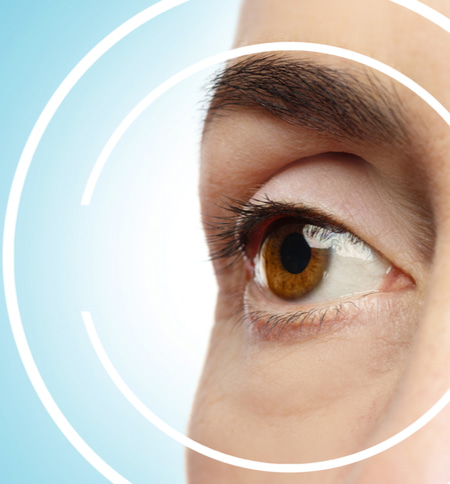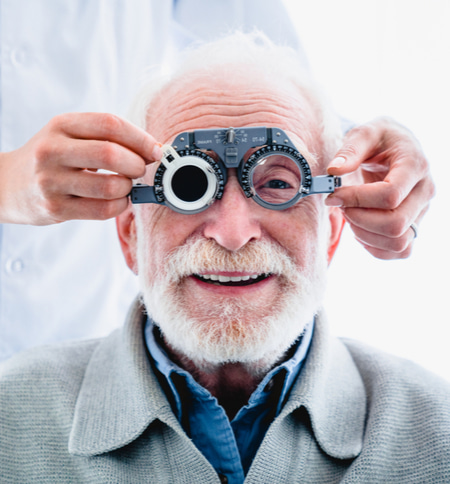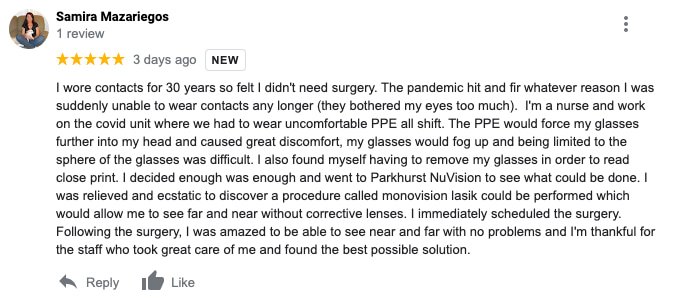Presbyopia & Reading Vision Correction
Has Your Close-up Vision Changed?
Our San Antonio Vision Specialists Have Solutions for Near Vision Changes
If you are struggling to see objects close-up and you are over the age of 40, presbyopia could be the cause of your blurry near vision. You are not alone—this age-related loss of near vision affects upwards of 128 million Americans.1 At Parkhurst NuVision in San Antonio, our eye doctors offer effective treatments for presbyopia that can help you avoid the hassle of reading glasses or bifocals.
"For the first time in 7 years, I didn’t reach for my glasses to read my emails the next day! Wonderful staff. Painless and I see 100% better!"
MarkSymptoms of Presbyopia
- Difficulty seeing clearly up-close, especially noticeable when reading
- Holding items such as your phone at a further distance away in order to focus
- Frequently squinting or using brighter lights to try to see more clearly
- Headaches or eye strain after long periods of reading or close work

Presbyopia is the reason that people start to use reading glasses in mid-life, even if they previously had perfect vision.
Why Does Presbyopia Happen?
To understand why presbyopia happens, you need to know a bit about the anatomy of your eye. The way you see an image is a result of the way that light filters into your eye. Light first goes through the cornea, which is the clear part of the front of your eye. It then enters the lens, which is clear and about the same shape and size as an M&M candy. The lens is flexible and moves in order to properly send the light to your retina, which is a layer of photosensitive cells at the back of the eye. Your retina then sends signals to your brain.
Presbyopia is essentially a dysfunction of the lens. As we age, the lens begins to stiffen and become less flexible. This stiffening causes the lens to lose the ability to zoom in and results in difficulty to see up close. The less flexible the lens becomes with age, the harder it is to clearly see a text message, read a label, or do certain hobbies like crafting, woodwork, or putting bait on your fish hook.

Presbyopia is a Natural Part of Aging—But You Don’t Have to Live With It
Reading glasses are typically the front-line solution for presbyopia, and if you already had eyeglasses or contact lenses for myopia (nearsightedness), hyperopia (nearsightedness) or astigmatism, then you are looking at bi-focals, trifocals, or the dreaded progressive glasses . The thing is that a lot of people hate wearing reading glasses , sometimes because they don’t like the way they look or the difficulty it adds doing certain things with them on. Other times, from the frustration of the on-off-on-off struggle as you switch between near and far tasks. This can lead to the problem of constantly misplacing your readers. We hear some patients say, “It is not fair, I need reading glasses to find my reading glasses.”
Luckily, we can help. At Parkhurst NuVision, we are dedicated to offering a full range of vision correction solutions. Your eyes are unique and we’ll work with you to create a customized treatment plan that restores your vision and improves your quality of life.

Presbyopia Solutions
- Refractive Lens Exchange
- Blended Vision Treatment
- Corneal Inlay
- Presbyopia Drops
Refractive Lens Exchange
RLE is our most highly recommended treatment for presbyopia because it has so many benefits and such a high patient satisfaction rate. Refractive Lens Exchange (RLE) cures presbyopia by solving the root of the problem—the lens. By correcting the stiff lens with a laser lens treatment, you can achieve the best vision of your life. This procedure not only treats presbyopia, but can also address nearsightedness, farsightedness, and astigmatism. The best part about this may be that it is a one time treatment as it prevents you from developing cataracts later in life.

Blended Vision Treatment
Blended vision is a technique that corrects for both far and near vision. It can be tested with contact lenses to make sure that it is right for you. For people who are candidates, blended vision LASIK can reduce or eliminate the need for reading glasses.

Corneal Inlay
A corneal inlay is a small device that is implanted in the eye in order to help light focus properly. Corneal inlays are typically recommended only for patients who have good distance vision.

Vuity Presbyopia Drops
We are excited to offer VUITY, the first and only eye drop available to temporarily treat presbyopia. This once daily eye drop works by constricting the pupil, creating a pin-hole effect, making it easier to read small print. This advancement is a revolutionary treatment solution in helping patients reduce their reliance on reading glasses.

"I am so grateful for everyone here at Parkhurst Nuvision. All the pre-ops and the procedure were informative and smooth."
Real Patient"They definitely lived up to their many 5 star reviews. Everyone I spoke to was SO friendly and helpful! I'm 42 years old."
JeanetteReal Reviews from Real Patients

Frequently Asked Questions About Presbyopia
Yes, if you had LASIK you will still experience presbyopia at some point. LASIK corrects imperfections in your cornea, but presbyopia is a problem with the lens.
Nope, unfortunately presbyopia will happen to all of us at some point. There are no eye exercises or supplements that can prevent your lens from stiffening.
Presbyopia can be diagnosed during a routine eye exam with your eye doctor.
This varies from person to person, but most people start to notice a change in their near vision in their early to mid-forties. People can develop presbyopia in their 30’s (this is called premature presbyopia) and some people don’t notice changes until their 50’s.
Farsightedness (hyperopia) and presbyopia are two different types of refractive errors. The difference is in the part of your eye that is affected. Farsightedness, which is usually genetic and occurs in adolescence, is due to an abnormality on your cornea. Presbyopia is an age-related change in the lens of the eye.
We Can Help You Lose Your Reading Glasses—For Good
Sick of buying yet another pair of reading glasses because you misplaced them or forgot to bring yours with you? Imagine the freedom of never needing them again! The highly experienced eye doctors at Parkhurst NuVision can help. Contact us today with any questions or to schedule your consultation appointment.

Ready for clear vision and freedom from glasses and contacts?
Request a consultation to get started!
"*" indicates required fields
1 Zebardast N, Friedman DS, Vitale S. The prevalence and demographic associations of presenting near-vision impairment among adults living in the United States. Am J Ophthalmol. 2017;174: 134–144.
2 Mayo Clinic. Presbyopia. Available: https://www.mayoclinic.org/diseases-conditions/presbyopia/symptoms-causes/syc-20363328 Accessed October 5, 2021.

